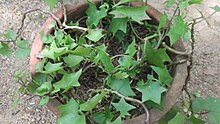
The family Asteraceae, with the original name Compositae, consists of over 32,000 known species of flowering plants in over 1,900 genera within the order Asterales. Commonly referred to as the aster, daisy, composite, or sunflower family, Compositae were first described in the year 1740. The number of species in Asteraceae is rivaled only by the Orchidaceae, and which is the larger family is unclear as the quantity of extant species in each family is unknown.
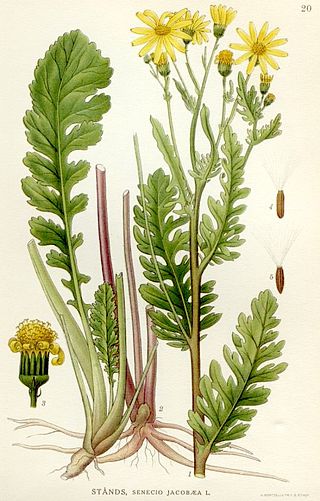
Jacobaea vulgaris, syn. Senecio jacobaea, is a very common wild flower in the family Asteraceae that is native to northern Eurasia, usually in dry, open places, and has also been widely distributed as a weed elsewhere.

Senecio vulgaris, often known by the common names groundsel and old-man-in-the-spring, is a flowering plant in the family Asteraceae. It is an annual herb, native to the Palaearctic and widely naturalised as a ruderal species in suitable disturbed habitats worldwide.
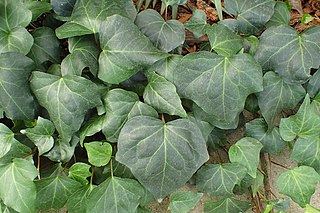
Hedera, commonly called ivy, is a genus of 12–15 species of evergreen climbing or ground-creeping woody plants in the family Araliaceae, native to Western Europe, Central Europe, Southern Europe, Macaronesia, northwestern Africa and across central-southern Asia east to Japan and Taiwan. Several species are cultivated as climbing ornamentals, and the name ivy especially denotes the commonly grown English ivy, which is frequently planted to clothe brick walls.

Cirsium arvense is a perennial species of flowering plant in the family Asteraceae, native throughout Europe and western Asia, northern Africa and widely introduced elsewhere. The standard English name in its native area is creeping thistle. It is also commonly known as Canada thistle and field thistle.

Delairea is a genus of flowering plants within the family Asteraceae. Currently, it only features two species: Delairea odorata from Southern Africa, and the recently discovered Delairea aparadensis from Southern Brazil, which is critically endangered. D. odorata formerly belonged to the genus Senecio as Senecio mikanioides.

Senecio brasiliensis, known by the common name flor-das-almas, (flower-of-souls), is a perennial species of the genus Senecio and family Asteraceae. It is native to fields and meadows of central South America.
Cape ivy or German ivy or parlor ivy or Italian ivy is probably:

Senecio angulatus, also known as creeping groundsel and Cape ivy, is a succulent flowering plant in the family Asteraceae that is native to South Africa. Cape ivy is a scrambling herb that can become an aggressive weed once established, making it an invasive species. It has been naturalised in the Mediterranean Basin, where it is grown as an ornamental plant for its satiny foliage and sweet-scented flowers.

Senecio tamoides, also known as Canary creeper, false grapevine, and parlor ivy, is a climbing member of the genus Senecio of the family Asteraceae that is native to Southern Africa. It is used as an ornamental plant for its showy yellow, daisy-like flowers in late autumn through to winter.
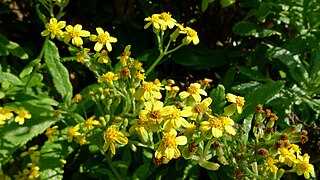
Senecio madagascariensis, also known as Madagascar ragwort, is a species of the genus Senecio and family Asteraceae that is native to Southern Africa. Other common names include Madagascar groundsel and fireweed. It has been included on the noxious weeds list for Hawaii and the reject list for Australia. S.madagascariensis is the diploid cytotype of S.inaequidens.

Parthenium hysterophorus is a species of flowering plant in the family Asteraceae. It is native to the American tropics. Common names include Santa-Maria, Santa Maria feverfew, whitetop weed, and famine weed. In India, it is locally known as carrot grass, congress grass or gajar ghas or dhanura. It is a common invasive species in India, Australia, and parts of Africa.

Diota rostrata is a species of moth of the subfamily Arctiinae first described by Wallengren in 1860. It is found in South Africa, Eswatini, Zimbabwe, Kenya and Ethiopia.
Digitivalva delaireae is a moth of the family Acrolepiidae that is endemic to South Africa.

Entyloma ageratinae, commonly known as the mist flower smut, is a leaf smut fungus and plant pathogen widely employed as a biological herbicide in the control of the invasive plant Ageratina riparia. The pathogen was first identified in Jamaica in 1974 and was isolated as a distinct species in 1988.

Galtara extensa is a moth of the subfamily Arctiinae first described by Arthur Gardiner Butler in 1880. It is found on the Comoros and in Madagascar.

Pseudogynoxys chenopodioides, known commonly as the Mexican flamevine, is a climber in the family Asteraceae, native to Mexico, Central America and the West Indies.

Senecio deltoideus, also known as Canary creeper or climbing ragwort, is a climbing herb native to Southern Africa and Eastern Africa. Its name "deltoideus" refers to the leaves being shaped like a triangle.
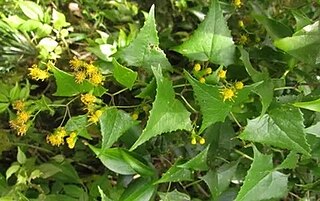
Delairea aparadensis is a new species in the Delairea genus native to Brazil, where it was described in 2021. Critically endangered using the IUCN criteria, it is the second species in the Delairea genus, with the first one being D. odorata.




